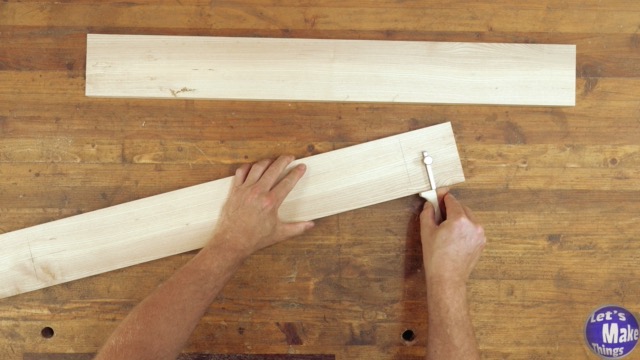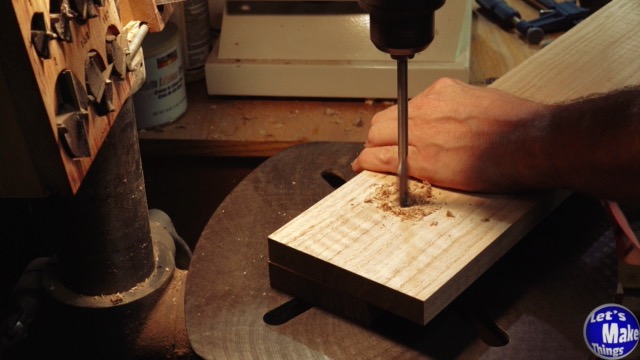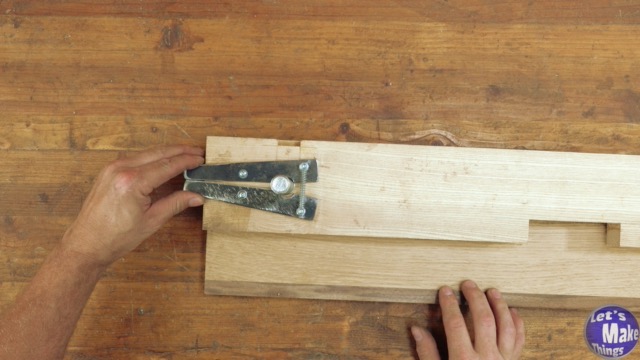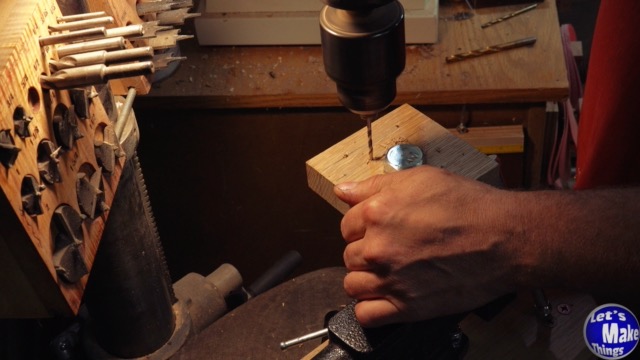Quad screw vise
(the Advanced Moxon Vise)
The double screw vise, more recently known as the Moxon vise, is a very old invention that’s used to hold stock, primarily for joint creation. Unlike our modern single screw vises with pins to line up the jaws, these vises have an open throat in the front that’s accepting of large stock. They also serve their masters well with the ability to clamp uneven stock.
The original creator has been lost to time, but the vise has been documented as far back as 1676 by André Félibien. There’s controversy as some will say that the images used in Joseph Moxon’s Mechanick Exercises book are copies from André’s work. While this juicy bit of gossip is fun to write about, I think it’s far from the truth. Watch the video for a bit more understanding of the legacy of the double screw vise.
ATTENTION: These plans are yours to use…they are offered as a gift from me to you. You have every right to use them to make this project for yourself, but please, do not sell or give these plans away as your own. I make absolutely no money off of these so I would appreciate those who view these plans to abide by basic copyright laws.
In this article, we’ll build an updated version that I’ve personally designed. I call it the “Quad Screw Vise” as it uses two sets of jaws instead of the original single, tightened by not two but four screws. The video below shows the entire process and you’ll find steps that will give you quick reference to the video so you’re not searching for the next step to follow. I hope they’ll serve you well. Please be sure to email me (link at the bottom) if you found any mistakes.
watch all steps in this video before starting
Please use the material and tool list below as a guide to finding products locally.
Materials
- 1″ x 6″ x 32″ Hardwood (Jaw: front)
- 1″ x 7″ x 32″ Hardwood (Jaw: Back)
- (2) 3/4″ x 4″ x 32″ Hardwood (Body)
- 1″ x 3 1/4″ x 32″ Hardwood (Jaw: Top)
- 3/4″ x 5″ x 32″ Hardwood (Jaw: Bottom)
- 1″ x 4″ x (Distance your dog hole is away from the edge and adding an inch and a half) hardwood
- (2) 3/4″ x 2″ x 4″ hardwood (to act as braces for the back)
- (2-4) 5/8″ SQUARE nuts
- (2-4) 5/8″ x 8″ Carriage bolts
- Wood glue
- Epoxy
- Hot glue
- Double sided tape
Optional (making handles instead of using knobs):
- 2 x 4 x 18″ Hard/Softwood
- 3/4″ (1 1/4″ long) Conduit
- 1/2″ x 2 3/8″ Conduit
- 3/16″ x 2″ x 14″ steel plate (the link is to a 36″ piece of steel)
- (2) 5/8″ x 20″ Threaded rod
- Thread locker
- (4) #6-32 3/4″ Pan head screw (flat underside)
- (2) #8 washer
- (4) #8-32 Hex nut
- (2) Springs (1-3/16L x 1/4ODx .032WG) (Ace H4rdware #120 (extension spring))
- Minwax paste or Boeing t-9
- Optional: (Clamp faces) Tracker Runner
- Optional: Mod Podge
Tools Needed/used
- Drill press
- Bandsaw
- Table saw
- Hacksaw
- 5/8″ Spade Bits
- Pencil
- Optional:
- Marking gauge (Optional, but oh so nice)
- Awl
- 11/16″, 13/16″ Spade Bits
- Countersink Bit or (Budget friendly)
- Chisel
- 5/8’s Tap and die set (for handle mechanism)
- Pocket hole jig or (budget friendly)
- Angle grinder
As an amazon associate I earn from qualifying purchases.
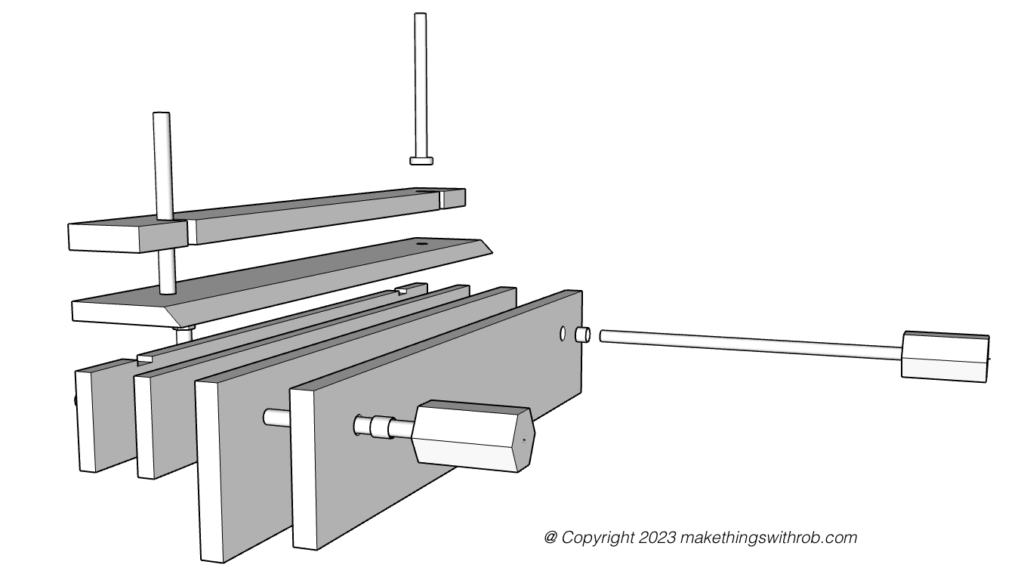
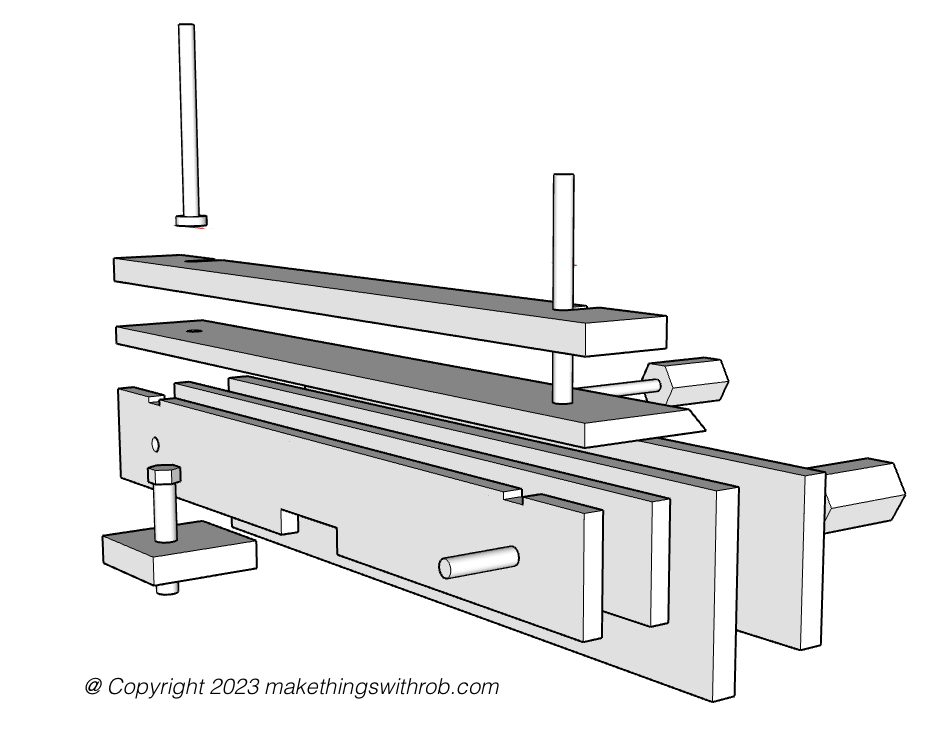
Step by step instructions
1. Mapping out the body
The “Body” consists of both the 3/4″ by 4″ by 32″ pieces. One is slightly different than the other due to needing to create a relief for the carriage bolt heads that jut down from the bottom of the bottom jaw.
We’ll also mark out the 4″ slot that will later be hogged out on the table saw.
After notching out the reliefs for future carriage bolts, we’ll glue both pieces of stock together.
2. prefacing the top and bottom jaw
The top and bottom jaw share the same distance from the edge for both of the vertical holes. The first part of this step is easy as we’re just mapping and drilling both holes. The second step, before any epoxy is added, is to cut a 90 on the bottom jaw, along the length of the board. This is important as it’ll prevent glue from sticking to our vise during glue ups as well as allowing our stock to come together without bumping into that corner.
We’ll set both carriage bolts before adding epoxy and allowing it to cure.
4. Drilling out the vertical holes
In this step we’ll drill out the holes for the two body pieces we glued earlier. Using the marks we added on the back will give us the location for the holes. Glue the body and both the front and back jaws together, with the front jaw the farthest below.
We’ll drill out the holes with a combination of bits. We’ll start with the 5/8’s drill bit and drill through the body and back of the jaw, leaving an indelible mark on the backside of the front jaw. Then I switched to my 15/16″ drill spade bit and drilled it the rest of the way.
Afterwards, glue the back jaw to the body.
* Not talked about in this video but I used an 11/16’s drill bit instead of a 5/8’s drill bit so that I could add 1/2″ conduit through the body and the back jaw. It’s a very difficult thing adding the conduit to 11/16’s holes which is why I omitted it (as well as the fact that some might not use the latch and handle part anyway), but I used a 1/2″ conduit to further enlarge the hole after I drilled it.
5. Latch and handle (optional)
The latch and handle are a very unnecessary thing to add to this vise. I personally love it. I wouldn’t use it without it. It allows me to use longer handles and I’m not running into the ends as much as I was with the simpler vise.
If you’d rather use carriage bolts, like step 2, don’t feel like your downgrading this project: You aren’t. It’s just a different way to do it. It’s also a more expensive route as you’ll have to buy a tap and die set. Again, for me, this was a lot of fun to make and I love using it.
The latch is nothing more than a piece of steel, cut in half and then attached with a few screws and a spring. Click on the image that’s attached to this step to see the full build for it as it is quite long to explain. This step will also quickly go over how to make the handles.
7. finishing the upper and front jaws
One thing that I can’t stress enough is to use tracker runner, which can be found in any department store. This will give your vise an excellent grip and you won’t be dependent on thick jaws to hold onto things. Friction is sometimes better than brute force.
I also cut out the hole on the upper jaw to allow this to slide into the carriage bolts. All very important things to do so you’re not taking the knobs off each and every time to remove the jaw.
8. Dog hole connection
If you chose to add a block of wood with a hex bolt in it to attach this to your vise, you’ll finish that process in this step. The block of wood needs to be 4″ wide (to work with the cut out we made earlier). The length of it needs to be the edge of your table and about an inch past the outer diameter of the hole. The hole will also be dependent on the dog holes on your bench.
9. Knobs
You’ll either use two knobs if you chose to make the handle or four if you chose to just use carriage bolts for the vertical clamp. Either way, I’ve prepared a video showing how to do it. You’ll either need 4 pieces of scrap stock or 8. This is the same knob used in the simpler version and I’m referencing the other video for this build.
Click the image to watch it.
Related videos
The bench knob
Quad Vise handle
Tip Jar
If you found any errors on the page, please use my email below and contact me!

